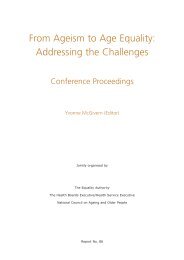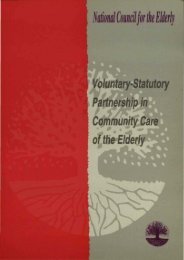Improving Quality of Life for Older People in Long-Stay Care ...
Improving Quality of Life for Older People in Long-Stay Care ...
Improving Quality of Life for Older People in Long-Stay Care ...
- No tags were found...
You also want an ePaper? Increase the reach of your titles
YUMPU automatically turns print PDFs into web optimized ePapers that Google loves.
Residents and their families should be asked directly about their experiences <strong>of</strong>quality <strong>of</strong> care and quality <strong>of</strong> life <strong>in</strong> residential care as part <strong>of</strong> the <strong>in</strong>spection andregulatory process and procedures carried out by a newly established SocialServices Inspectorate <strong>for</strong> long-stay care. In<strong>for</strong>mation should be published regularlyon the results <strong>of</strong> <strong>in</strong>spections, <strong>in</strong>clud<strong>in</strong>g specific <strong>in</strong><strong>for</strong>mation on care environmentand ethos <strong>of</strong> care, sense <strong>of</strong> self and identity among residents, social connectednessand mean<strong>in</strong>gful activities and therapies. As part <strong>of</strong> the new emphasis on quality <strong>of</strong>life, all long-stay facilities should be mandated to develop appropriate consultationstructures designed to give older people a voice <strong>in</strong> how the facility is run, <strong>in</strong>clud<strong>in</strong>gwhat services are provided to residents.New <strong>in</strong>vestment is also required <strong>in</strong> respect <strong>of</strong> public long-stay facilities to replacean age<strong>in</strong>g capital stock that, <strong>for</strong> the most part, was not designed to cater <strong>for</strong> theneeds <strong>of</strong> dependent older people. Un<strong>for</strong>tunately, regulations on the design <strong>of</strong> carebuild<strong>in</strong>gs have accumulated over time with little knowledge <strong>of</strong> their impact on thequality <strong>of</strong> life <strong>of</strong> build<strong>in</strong>g users. This must change and any new <strong>in</strong>vestment mustbe small-scale and facilitate the <strong>in</strong>dependence <strong>of</strong> residents. Build<strong>in</strong>g features thatmaximise choice and control, privacy, social connectedness, physical support,cognitive support, com<strong>for</strong>t and personalisation will enhance the quality <strong>of</strong> life<strong>of</strong> residents. The physical care environment and overall design <strong>of</strong> the build<strong>in</strong>gsare particularly important <strong>for</strong> people with dementia. F<strong>in</strong>ally, good quality facilitiesshould be rewarded with extra resources and residents, while poor qualityproviders, whatever their orig<strong>in</strong>s, should be named, shamed and prosecuted.229In conclusion, it is evident that much work rema<strong>in</strong>s to be done <strong>in</strong> ensur<strong>in</strong>g agood quality <strong>of</strong> life <strong>for</strong> older people resident <strong>in</strong> long-stay care. To date, not enoughattention has been paid by policy-makers and regulators to quality <strong>of</strong> life and theyhave <strong>in</strong>stead chosen to focus their attention on ensur<strong>in</strong>g a good quality <strong>of</strong> care ismade available <strong>in</strong> long-stay residential care. While this can be justified by the centralrole played by these facilities as providers <strong>of</strong> care and the more tangible nature <strong>of</strong>quality <strong>of</strong> care <strong>in</strong>dicators, the prom<strong>in</strong>ence given to quality <strong>of</strong> care, while necessary,is not sufficient and it is imperative that quality <strong>of</strong> life <strong>in</strong> long-stay care is giventhe due recognition it deserves. <strong>Older</strong> people <strong>in</strong> long-stay care are more than justpatients; they are <strong>in</strong>dividuals who deserve to live the rema<strong>in</strong>der <strong>of</strong> their days withdignity and respect <strong>in</strong> an environment that is empower<strong>in</strong>g and enabl<strong>in</strong>g, notbelittl<strong>in</strong>g. It is not only policy-makers that have to change; management and staffalso need to change and see their roles <strong>in</strong> terms <strong>of</strong> develop<strong>in</strong>g quality <strong>of</strong> life asmuch as quality <strong>of</strong> care. <strong>Long</strong>-stay care sett<strong>in</strong>gs are not places to die; they areplaces to live and live well. The impetus is now on regulators, policy-makers andpractitioners to ensure that residents <strong>of</strong> long-stay care are guaranteed the bestquality <strong>of</strong> life possible <strong>in</strong> these sett<strong>in</strong>gs as well as the best possible care.















